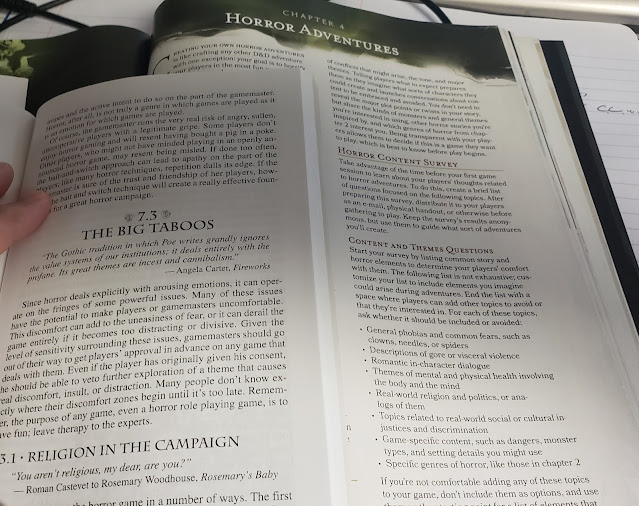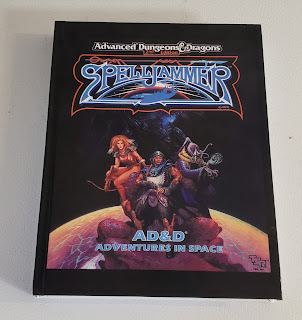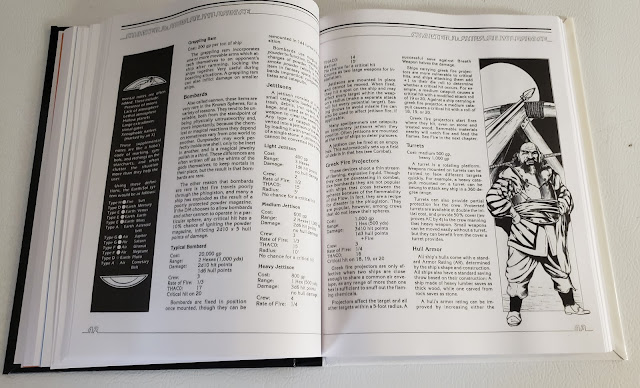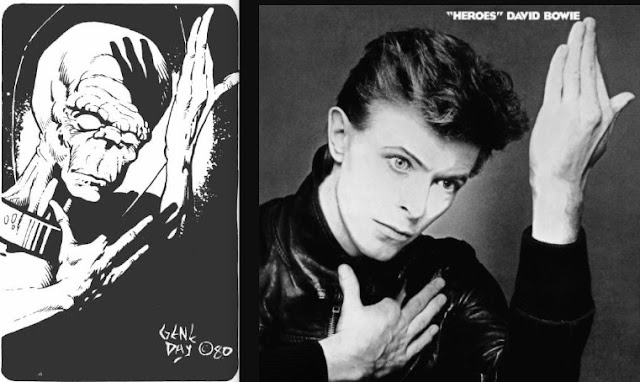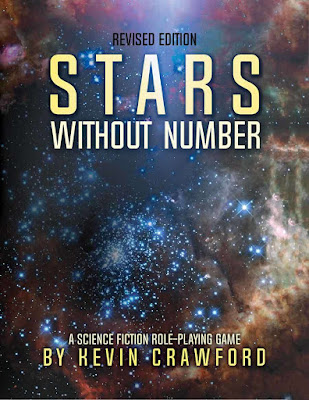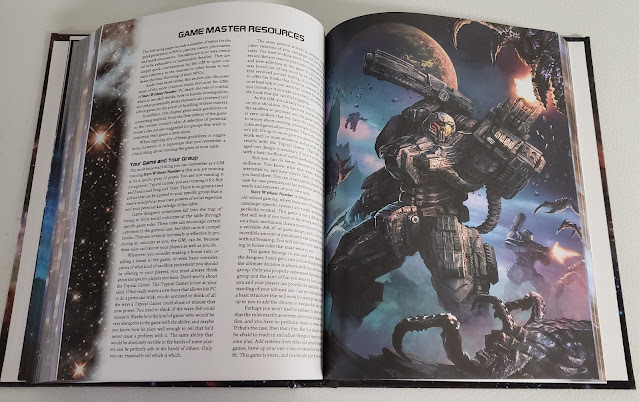Chapter 4: Horror Adventures
This chapter covers how to do horror in Ravenloft. No to be sure this is "how to do horror in the situated rules of D&D and Fantasy Heroics." It is not, nor should it be "how to do Horror for every other RPG out there." The advice is good, but only when used in the proper situations and circumstances. The advice given here is good advice, and it is not dissimilar to any number of horror games I have played in the past.
For reference, I compared this chapter to some other horror games and books I have here. In particular, I used:
- Nightmares of Mine, 1999 Iron Crown Enterprises and Chaosium, written by Kenneth Hite.
- Spooky: The Definitive Guide to Horror Gaming, 2001 Hex Games, written by Steve Johnson
- Call of Cthulhu: 30th Anniversary Edition, 2011 Chaosium, written by Sandy Petersen, etal.
- Chill Horror Role-Playing Game, 1990 Mayfair Games, written by David Ladyman
These are the ones I use the most, though I could grab examples from another couple dozen or so games.
VRGtR covers Preparing for Horror and this covers not just what sort of horror game everyone wants to play it also covers things like consent. Yes. Consent. No this is not a political stance, it is what I like to call "not being a fucking dick about it." Section 7.3 of Nightmares of Mine states that
"Even if the player has originally given his consent, he should be able to veto further exploration of a theme that causes real discomfort, insult, or distraction. Many people don't know exactly where their discomfort zones begin until it is too late."- Nightmares of Mine, p. 119
And that was written over 20 years ago. If you are complaining about consent being part of a horror game you lost that battle a long time ago.
Ravenloft's Session 0 (p. 186) almost matches perfectly to Spooky's "Pre Game Checklist" (p.34) in terms of what sort of horror game is this? Who are the characters? What purpose does the story serve? Spooky asks "What is the Monster?" Ravenloft asks "Who is the Darklord?"
VRGtR also covers the physical environment to running a horror game. This includes advice, while not exactly cribbed from 2nd Ed Ravenloft, certainly inspired by it. This includes dimming the lights, props, music, and so on. Chill also addresses this throughout their game. No shock, Chill 2nd Ed and Ravenloft both came out of the same section of the upper midwest at pretty much the same time.
There is also a section on using the Tarokka Deck (there are many available) and the spirit board that is replicated on the last page of the book. I am hoping that one becomes commercially available.
Pause for a second here and consider this. D&D along with Ouija Boards were a favorite target of busy moms and the Christian far-right during the Satanic Panic. Now consider this. Ravenloft is back, full of all sorts of horror themes AND there is their own version of a spirit board included. And yeah it is still getting attacked. I guess some things never change.
There is a fun Horror Toolkit that includes some great Curses to lay down on people, places or whatever needs it. Similar to what we saw in the AD&D Forbidden Lore set. There is a Fear and Stress mechanic. Madness is gone. Good ridance. Here is something I wrote about Madness in my own Sanity in Ravenloft: Masque of the Red Death. 1997.
I have always had a problem with the way that the various Ravenloft rulebooks have handled fear, horror and madness checks, but madness in particular. In real life and in most Gothic literature, madness is a gradual thing, usually built up over long periods of time; think of the madness as described in Poe or even Lovecraft. The Madness checks from Ravenloft and later Masque of the Red Death were an all or nothing affair, one failed roll could turn anyone into a raving lunatic. Plus the rules in The Realms of Terror and the Masque of the Red Death books mostly dealt with madness as an after effect of psionic interference. Of course millions of people suffer from mental illness without the “benefit” of being psionic.- Sanity in Ravenloft: Masque of the Red Death. 1997
I wrote that because as someone with multiple degrees in psychology and a former Qualified Mental Health Professional I have NEVER been happy with how any RPG's system for "Madness" or "Sanity" worked. Call of Cthulhu was an exception because what it did was so closely tied to the stories it emulated. I attempted to do the same.
This new system works better for the Fantasy Horror of Ravenloft. For me, the guy who used to be in charge of the night shift at a mental facility for schizophrenics, this system is better. Yeah, people are going to say "but madness is part of horror!" No. It is part of Gothic Horror and to a degree Cosmic Horror, but there is nothing in Fantasy Horror that needs Madness. Yes, you can use it. No, you don't NEED to use it. AD&D 2nd Ed used it, I used my own mechanics. I am happy to drop both today.
Though, there is no corruption mechanic here or a fall to Dark Powers. The underlying assumption is that the PCs are heroes in the pure and true sense. That is great, but D&D 5 players are no different than AD&D 1st ed players. Dangle power in front of them and they will grab it with both hands and ask for more. I get that, I really do and it works for this game. I am going to have to see how it works for me as I play Ravenloft 5e. On one of the few times I was a Ravenloft player and not a DM I had a character, a cavalier-sort, who was sucked in to the Mists and went blind. He gained the ability to "see" while fighting but no other time (think Daredevil) it was a struggle to keep him from reaching out for more. He did move from Lawful Good to Lawful Neutral, but that was as far as his slide went.
Moving on to a GREAT piece are Survivors. Survivors are a little bit more than normal humans, and a little bit less than a 1st level character. These would be the people/characters in Ravenloft that would have souls. There are four basic types and they map on perfectly to the four class archetypes.
- Apprentices have a minor talent for magic (Wizards, Magic-Users)
- Disciples adhere to the tenets of the faith (Priests, Clerics)
- Sneaks survive by their wits and are petty thieves. (Rogue, Thief)
- Squires have some martial prowess or training. (Warrior, Fighter)
There are stat blocks for these four on the following page. They get a minor talent (like a feat, but not as strong). Basically, they are Basic D&D 1st level characters. If I was going to start a Ravenloft game, I would figure out what everyone wanted to play and then give them these level 0.5 characters that match their archetype. Playing a Warlock? You start out as an Apprentice. And so on.
The House of LamentThe included adventure deals with the House of Lament. To new players it is a creepy ass haunted house that holds the spirits of Mara Silvra and Dalk Dranzorg (which are totally names you would find in Glantri, just saying). To older fans, the House of Lament was just as evil. Now Mara goes from helpless victim to warrior now complicit in her own damnation in Ravenloft. In both cases, her body is entombed in the house and her spirit haunts it. The House of Lament was introduced in one of the first accessories for Ravenloft, RR1 Darklords which was released in 1991. This new house has all the chills of the first.
There are rules for séances and the replies from the various spectral inhabitants. There is even a handy adventure flowchart. You don't have to follow it, but it does help. The new house pretty much looks like the one in Darklords. The maps are not 100% the same, but close enough that is obvious there are supposed to be the same place. Or at least built by the same hand. BTW the maps of the House of Lament are by none other than Dyson Logos.
The change is interesting and hits on things we all talked about online back in the 90s. So in the original House, Mara was an innocent victim, yet her soul was stuck in this house with the other spirits. We always wondered why the Mists would trap an innocent soul. We came up with a lot of reasons, but the current authors bypass the issue altogether and make Mara more active in her placement here.
Still, tt is a great introductory adventure.
Chapter 5: Monsters of Ravenloft
The very last part is a collection of new (well...new to some) monsters found in the Mists and Domains of Ravenloft.
First, we get a bit about how to use monsters in a horror game. It is good but I do feel it could have been longer. Then we get into the monsters themselves. First off. I LOVE the Bagman! Why I never came up with it myself I will never forgive myself for. We get the expected cast. Invasion of the Body Snatchers Pods, Brain in a Jar, Boneless, evil dolls, headless horsemen, ghosts, Star Spawn of Cthulhu Emissary, slashers, couple of different Vampires, zombies. The expected cast. Given Ravenloft's history, there are tons more that could be added. Well, it will keep the folks on DMsGuild busy for a long time!
Ok. So. Let's address it. The monsters do not have alignments listed. "Oh no" the cries come from the Internet, "nothing is evil anymore! D&D is DOOOOMED!" Oh, grow the fuck up.
I have lost track of how many times over the last 40 years someone has brought up "hey maybe we should get rid of alignments in D&D." Also aside from Ravenloft how many Horror RPGs have alignments? Right. None. Well...maybe Beyond the Supernatural. Just checked, yeah it does, but none of the other non-D&D-derived Horror games have it. One thing is made abundantly clear, monsters are there to be fought and fought against. There is no "Subjective morality" here the monsters are described in terms of their "Wrongness" (p. 224) or their nightmarish qualities (p. 225). To be clear here every monster listed either wants your soul, your body, your blood, your life, or some combination of all the above. In truth, there should never be anything at all like a random monster. Everything should be in place to maximize the effect the DM is wanting. At no point should a random goblin show up in the middle of investigating an undead killer moving through the streets. Every monster should thought out, planned and figured out where they exist in the ecology of fear the DM is creating. If that means a Boneless is a horrible creature trying to attack OR is it a helpless victim that needs the PCs, then alignments printed on the page would not matter.
My only complaint about this chapter is there needs to be more. But I do love my monsters.
We end with an art page of the spirit board.
Edited to Add: Wizards of the Coast has a free PDF where you can print out the Ravenloft Spirit board. Print it out and glue it to some wood or cardboard.
All in all this is my favorite D&D 5 book. I can see myself reviving (reanimating?) my old Ravenloft game with these new rules. My original players are all over the world now, but I have new ones. OR what I am more likely to do is add elements of Ravenloft into my current games. The Second Campaign is headed to a large desert. You know that Ankhtepot is going to be there.
There has been much ado about the changes to the Vistani. They are less of a cultural stereotype now so that is good. They can be good, or evil, as individuals choose, so that is also good. Generally improved all the way around. I have to be honest, I never used them very much save in Barovia, but that was it.
With all the other D&D books out now you can build quite a collection of resources for Ravenloft. The Candlekeep mysteries adventure, Book of the Raven, was our D&D 5 introduction to the Vistani and some Ravenloft concepts.
The new various "Guides" have plenty of monsters and other ideas to flesh out your Ravenloft for 5e.


